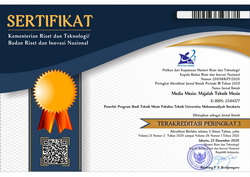EFFECT OF STAINLESS STEEL 304 TIG WELDING AMPERE ON STRESS CORROSION CRACKING PHENOMENON
Moch Chamim(1*), Farit Ardiyanto(2)(1) Mechanical Engineering Sekolah Tinggi Teknologi "Warga" Surakarta
(2) Electrical Engineering Sekolah Tinggi Teknologi "Warga" Surakarta
(*) Corresponding Author
Abstract
Keywords
Full Text:
PDFReferences
Anon, “Corrosion of Stainless Steels.,” Eng., vol. 218, no. 11, pp. 1207–1209, 1978, doi: 10.1016/B978-0-12-803581-8.02893-9.
J. Xin, Y. Song, C. Fang, J. Wei, C. Huang, and S. Wang, “Evaluation of inter-granular corrosion susceptibility in 316LN austenitic stainless steel weldments,” Fusion Eng. Des., vol. 133, no. September 2017, pp. 70–76, 2018, doi: 10.1016/j.fusengdes.2018.05.078.
X. Li, J. Liu, J. Sun, X. Lin, C. Li, and N. Cao, “Effect of microstructural aspects in the heat-affected zone of high strength pipeline steels on the stress corrosion cracking mechanism : Part I . In acidic soil environment,” Corros. Sci., no. June, p. 108167, 2019, doi: 10.1016/j.corsci.2019.108167.
L. Dong, Q. Peng, E. Han, W. Ke, and L. Wang, “Stress Corrosion Cracking in the Heat Affected Zone of a Stainless Steel,” Eval. Program Plann., 2016, doi: 10.1016/j.corsci.2016.02.030.
W. Chung, J. Huang, L. Tsay, and C. Chen, “Stress corrosion cracking in the heat-affected zone of A508 steel welds under high-temperature water,” J. Nucl. Mater., vol. 408, no. 1, pp. 125–128, 2011, doi: 10.1016/j.jnucmat.2010.10.052.
B. A. Kessal, C. Fares, M. H. Meliani, A. Alhussein, O. Bouledroua, and M. François, “Effect of gas tungsten arc welding parameters on the corrosion resistance and the residual stress of heat affected zone,” Eng. Fail. Anal., p. 104200, 2019, doi: 10.1016/j.engfailanal.2019.104200.
B. Singh, P. Singhal, and K. K. Saxena, “Investigation of thermal efficiency and depth of penetration during GTAW process,” Mater. Today Proc., vol. 18, pp. 2962–2969, 2019, doi: 10.1016/j.matpr.2019.07.166.
Z. Chen, J. Chen, and Z. Feng, “Welding penetration prediction with passive vision system,” J. Manuf. Process., vol. 36, no. October, pp. 224–230, 2018, doi: 10.1016/j.jmapro.2018.10.009.
F. J. Cárcel-Carrasco, M. Pascual-Guillamón, L. S. García, F. S. Vicente, and M. A. Pérez-Puig, “Pitting corrosion in AISI 304 rolled stainless steel welding at different deformation levels,” Appl. Sci., vol. 9, no. 16, 2019, doi: 10.3390/app9163265.
Y. Chen, B. Yang, Y. Zhou, Y. Wu, and H. Zhu, “Evaluation of pitting corrosion in duplex stainless steel Fe20Cr9Ni for nuclear power application,” Acta Mater., vol. 197, pp. 172–183, 2020, doi: 10.1016/j.actamat.2020.07.046.
E. Arzaghi, B. H. Chia, M. M. Abaei, R. Abbassi, and V. Garaniya, “Pitting corrosion modelling of X80 steel utilized in offshore petroleum pipelines,” Process Saf. Environ. Prot., vol. 141, pp. 135–139, 2020, doi: 10.1016/j.psep.2020.05.024.
X. Wang et al., “Pitting corrosion of 2Cr13 stainless steel in deep-sea environment,” J. Mater. Sci. Technol., 2020, doi: 10.1016/j.jmst.2020.04.036.
L. Feng et al., “A parametric study on effects of pitting corrosion on steel plate’s ultimate strength,” Appl. Ocean Res., vol. 95, no. December 2019, p. 102026, 2020, doi: 10.1016/j.apor.2019.102026.
Article Metrics
Abstract view(s): 891 time(s)PDF: 617 time(s)
Refbacks
- There are currently no refbacks.








